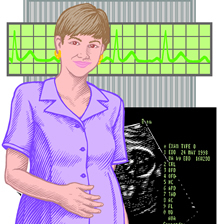 |
| In this Issue: | |||||||
HRSA Helps Bring Toledo Leaders Together to Improve Birth Outcomes
“The sessions promote partnerships among HRSA grantees and local organizations to encourage greater collaboration to improve community health outcomes,” said Becky Spitzgo, associate administrator of HRSA’s Office of Performance Review, which oversees the work of the regional offices. Last year OPR staff conducted 19 strategic partnership sessions with states and communities. One of them was in Ohio. In April 2007, during the Lucas County community partnership session, HRSA Region V Director Rick Wilk and colleague Josephine Ansah encouraged discussions among representatives of grantees and organizations to work together to reduce low birth weight births in Lucas County, where the rate is high. Toledo is the county seat and largest city in Lucas County. Wilk helped participants identify significant local health disparities and the resources needed to take them on. Wilk said he helped the emerging coalition “get more focused by asking the right questions, giving members courage to set bold goals and connecting them to people who’d already had success.” The discussions led to the creation of the Lucas County Initiative to Improve Birth Outcomes (LCIIBO), whose partners include the Toledo Community Foundation, the Stranahan Foundation, the Cleveland Foundation/Medical Mutual Foundation, Mercy Health Partners, ProMedica Health System, the March of Dimes and the Hospital Council of Northwest Ohio. The aim of the initiative was to reach deep into the county’s most at-risk communities to save the lives of at least 14 babies who might otherwise have been lost due to low birth weight complications and to teach at-risk women how to take better care of themselves. After looking at statistics by county zip codes to see where most low birth weight babies were coming from, the initiative got underway. A May 8, 2008, project update indicated that the LCIIBO serves 108 women and has provided 406 prenatal visits (an average of 3.8 prenatal visits per client) with 23 births so far. The number of healthy-weight births — defined as births at weights greater than 5 lbs., 8 oz. — was 18, which meets a project goal. The initiative is based on a model of care coordination drawn from the work of Mansfield, Ohio, pediatricians and primary care physicians Mark and Sarah Redding. In the early 1980s, the Reddings, who advise LCIIBO, practiced in a remote Alaska village with a remarkable birth outcome record. Expectant mothers there relied on health workers, also members of their community, to get the help they needed to have healthy babies. The LCIIBO initiative translates that model into a low-income urban environment. LCIIBO care coordinators, usually community health workers or social workers, also have roots in the local community. They often visit at-risk women in their homes to collect data and make sure their clients get prenatal care and parenting education. Mark Redding said care coordinators are accountable for helping women receive the “meaningful” services they need to be able to access direct services like prenatal care. If an expectant mother is living in a homeless shelter, for example, the coordinator connects her to resources to find housing. If a pregnant woman lacks transportation to prenatal appointments, the coordinator links her to services for a regular ride. “When Lucas County first confronted birth outcomes, they found that local agencies had not been able to get those most at-risk into care,” Mark Redding explained. “Now the initiative is helping more than 100 women from intensely impoverished neighborhoods access available county services.” LCIIBO project director Jan Ruma said “the project doesn’t just lay over the top of the system, it encourages change within the system. Our partners are learning that reaching out to those most at-risk can improve birth outcomes.” With three years of funding from local partners at about $200,000 a year, LCIIBO hopes to continue to be able to make a difference. “It’s also been wonderful to have HRSA involved,” Ruma added. “People say, if HRSA’s interested, I should be, too.” |
|||||||
